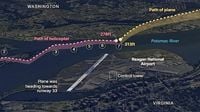New investigations by the New York Times have revealed that a deadly midair collision over Washington, D.C., in January involved significant breakdowns in helicopter pilot actions, communication, and air traffic control procedures. The incident, which took place on January 29, 2025, has raised broader concerns about aviation safety at Reagan National Airport.
The collision occurred between a U.S. Army Black Hawk helicopter and an American Airlines regional jet, resulting in the tragic deaths of all 67 people aboard both aircraft. The Black Hawk, piloted by Captain Rebecca Lobach, failed to follow critical instructions from air traffic control, leading to the disaster. Co-pilot Chief Warrant Officer 2 Andrew Loyd Eaves reported that Lobach ignored directives to change course just seconds before the crash.
Brig. Gen. Matthew Braman stated that investigators would find multiple factors contributing to the fatal crash. The investigation revealed that the Black Hawk crew made several mistakes during the mission, including failing to execute proper visual separation, a procedure designed to allow pilots to navigate around other aircraft independently.
According to the Times, there was no indication that Captain Lobach suffered from health issues during the moments leading up to the crash. The helicopter was reportedly flying at an altitude above the designated maximum for its route, which placed it directly in the landing path of American Airlines Flight 5342, arriving from Wichita, Kansas.
Transportation Secretary Sean Duffy highlighted the alarming frequency of near-misses at Reagan National Airport, noting that there have been 85 incidents in recent years. He stated, "We’re having near-misses, and if we don’t change our way, we’re going to lose lives." Investigators from the National Transportation Safety Board (NTSB) noted that multiple factors contributed to the crash, including miscommunication among the pilots and deviations from safe altitude.
The Black Hawk crew was operating under “see and avoid” rules, which transferred the primary responsibility for maintaining a safe distance from other aircraft from controllers to the pilots themselves. However, aviation experts have criticized this approach, stating that it has contributed to several fatal midair collisions over the past decade.
The crash occurred against a backdrop of chronic staffing shortages and procedural gaps at Reagan National Airport. On the night of the incident, one air traffic controller was managing both helicopter and fixed-wing traffic simultaneously, an arrangement typically reserved for periods of lighter activity. The controller approved the Black Hawk’s request for visual separation but failed to issue clear and urgent warnings as the helicopter and jet converged.
Furthermore, the Black Hawk crew had intentionally disabled the Automatic Dependent Surveillance-Broadcast (ADS-B) system, which would have allowed air traffic controllers to track their movements more accurately. This forced controllers to rely on radar updates that refreshed only every five to twelve seconds, significantly increasing the risk of collision.
In the final moments before the crash, the Black Hawk crew failed to respond to crucial air traffic control instructions. The crew was reportedly alerted to the presence of the American Airlines jet but did not make the necessary course corrections. The helicopter was approximately 15 seconds away from crossing paths with the jet when Eaves attempted to alert Lobach that a left turn was needed to avoid the plane. Unfortunately, Lobach did not alter course, and the helicopter continued directly into the jet’s path.
The collision took place at 8:47:59 PM, resulting in a fiery explosion that lit the night sky over the Potomac River. Investigators have since highlighted that multiple layers of safety precautions failed that night, leading to the worst domestic aviation disaster in the U.S. in nearly 25 years.
The investigation into the incident has unveiled a complex chain of events that contributed to the tragedy. The NTSB is expected to release a detailed report by early 2026, which will shed further light on the causes of the crash.
In response to the incident, the Federal Aviation Administration (FAA) has implemented new restrictions on helicopter flights around Reagan National Airport. The agency has mandated that a dedicated controller now oversee all helicopter operations in the airport's airspace, a measure aimed at preventing similar tragedies in the future.
Additionally, the FAA has permanently closed a route along the Potomac River that directly intersected with the flight path for the runway where the collision occurred. These changes reflect a growing recognition of the need for improved safety measures and oversight in the busy airspace surrounding the nation's capital.
The crash has raised serious questions about the safety protocols in place at airports like Reagan National. A review by the NTSB found at least one close call per month between airplanes and helicopters near the airport from 2011 to 2024, with most incidents occurring at night. Many of these incidents involved helicopters flying higher than authorized altitudes, further underscoring the need for stricter enforcement of aviation regulations.
As the investigation continues, families of the victims are left grappling with the loss of their loved ones in a tragedy that could have been prevented. The devastating collision serves as a stark reminder of the importance of adherence to safety protocols and the need for ongoing vigilance in the aviation industry.
In the wake of the crash, officials and aviation experts alike are calling for a reevaluation of current practices to ensure that safety remains the top priority in the skies. As the final NTSB report approaches, the hope is that it will provide clarity and lead to meaningful changes that will enhance the safety of air travel for all.



